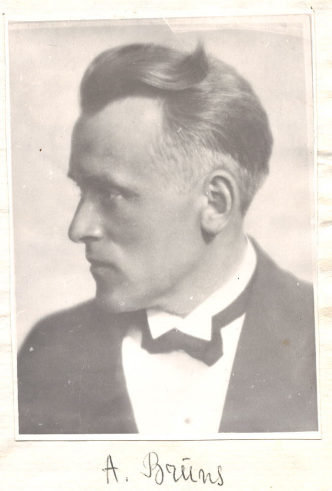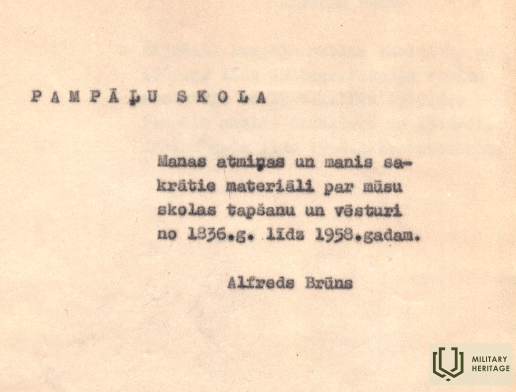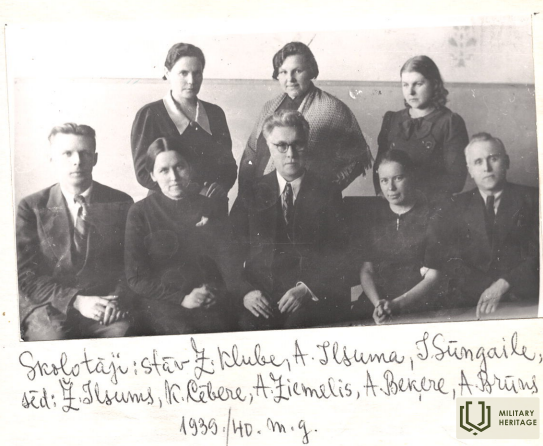Vokiečių armijos divizijos štabo požeminis bunkeris netoli „Sirsniņi“ namo Pampalyje
Alfredo Brauno pasakojimas apie vokiečių štabą jo gimtųjų namų kieme, kur vokiečių kareivis, prisidengdamas naktimi, vedė Alfredą užrištomis akimis, nežinodamas, kad šis namas yra jo gimtasis namas ir Alfredas net užmerktomis akimis pažinojo kiekvieną akmenį kieme.
Buvęs Pampāli mokyklos direktorius (iki 1959 m.) Alfredas Brūnas 1961 m. vasarį parašė laišką savo įbroliui Reiniui Hartmaniui į Didžiąją Britaniją. Reinis H. išsiuntė perrašytus A. Brūno laiškus savo sūnui į Australiją. Laimingo atsitiktinumo dėka užrašų knygelė su perrašytais laiškais atsidūrė Pampāli pas Artūrą Hartmanį, kuris turi įspūdingą privačią Antrojo pasaulinio karo artefaktų, rastų Pampāli apylinkėse, kolekciją.
Pirmasis Alfredo Browno laiškas 1961 m. vasarį.
[…] Neįtikėtina, kad praėjo 16 metų ir 3 mėnesiai nuo tada, kai „Hearts“ aikštė liko tuščia ir tyli. […]
Iš visų... žmonių aš paskutinis likau mūsų pusėje. Penkias savaites, iki 1944 m. gruodžio 20 d., vienas gyvenau Pampalių mokykloje. Gyvenau mokyklos rūsyje ir laukiau, kol praeis frontas. Per šias penkias savaites, mokyklai esant pirmoje ugnies linijoje, patyriau daug bauginančių, siaubingų, pavojingų dienų. Mokyklą palaidojo ir minų svaidytojai, ir šautuvų kulkos, sienos buvo išraižytos tankų šūvių, artilerijos ir lėktuvų bombų, ir taip penkias savaites viename pragare.
Galiausiai ir man tai pradėjo nervintis.
Mane išvedė prieš uraganą ir mokyklos deginimą 1944 m. gruodžio 20 d. Gruodžio 20, 23 ir 24 dienomis sudeginau mokyklą. Iš tos vietos dvi naktis mačiau šviesą iš tolo (Lukiuose). Po to buvau pabėgėlis Kuržemės maiše iki kapituliacijos gegužę netoli Ilzumo.
Kai mane iš mokyklos išvedė vokiečių kareiviai, divizijos vadui leidus pasilikti Lukiuose, man buvo leista naktį įeiti į „Sirsninę“.
Buvo tamsi naktis, kai kareivis vedė mane už rankos vingiuotais „Sirsninių“ ūkio takeliais, tada nusileidome giliai į požeminį bunkerį, kur buvo šviesu ir prie ilgo stalo buvo susirinkę apie 10 vyresniųjų karininkų. Vargšas kareivis negalėjo žinoti, koks pažįstamas šis namas ir jo ūkis, o tamsoje aš žinojau kiekvieną vietą, į kurią buvau vedamas.
Šis požeminis būstas buvo pastatytas tvarte, daubos link. Kai gegužę grįžau ir aplankiau „Sirsniņas“, tarp daugelio sugriautų namų ant kalvos išdidžiai ir nepažeistai stovėjo vienas raudonų plytų namas. Tik vienas kampas, nukreiptas į Pumpuri, buvo visiškai išplėštas ir stovėjo neremontuotas apie 12 metų. […]








